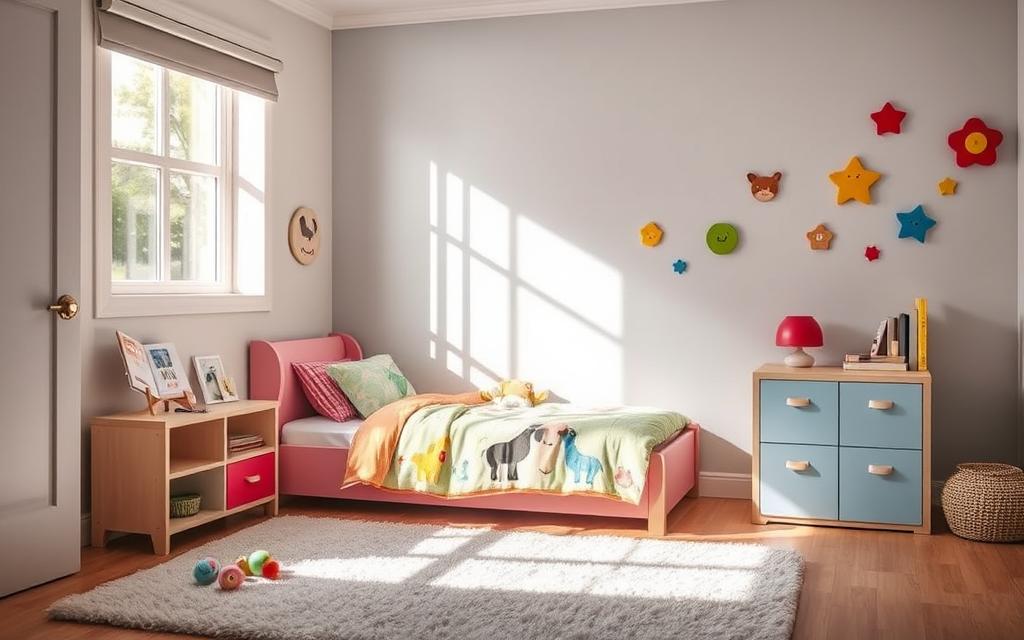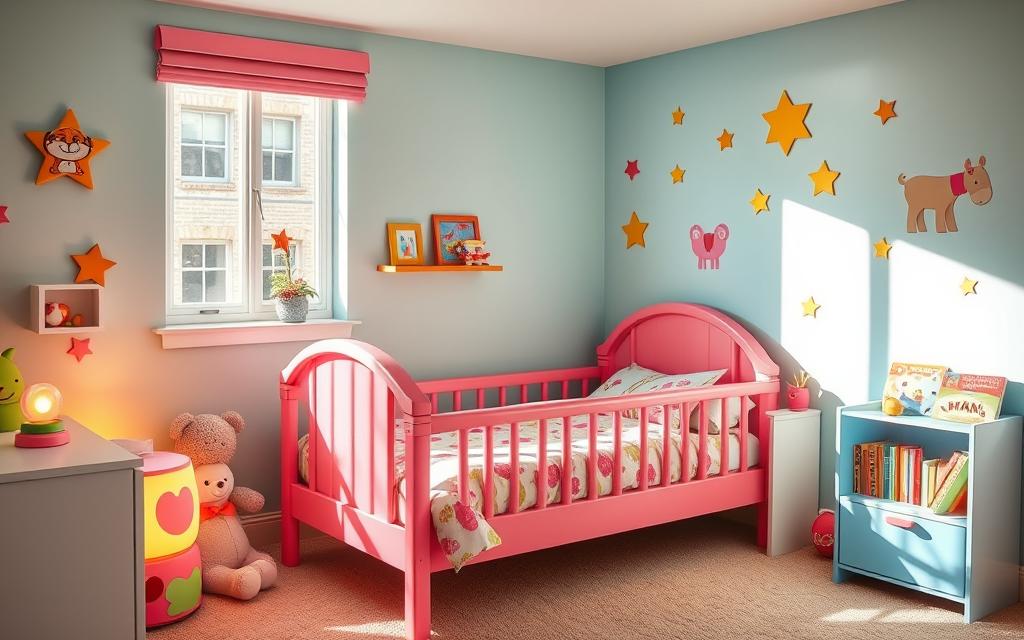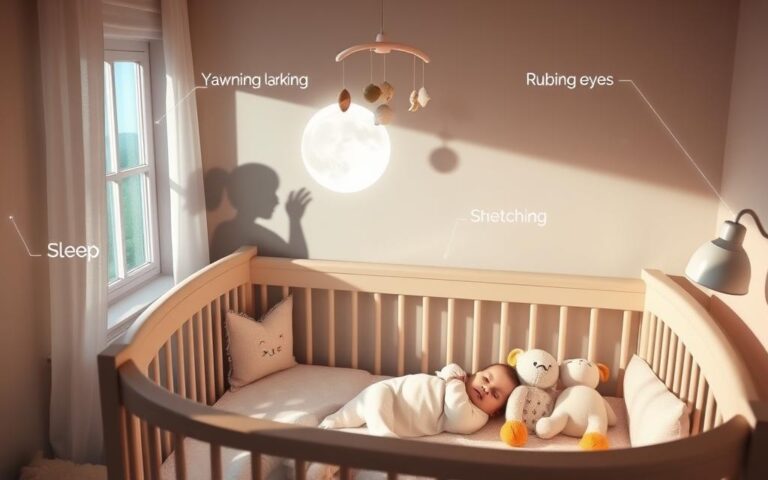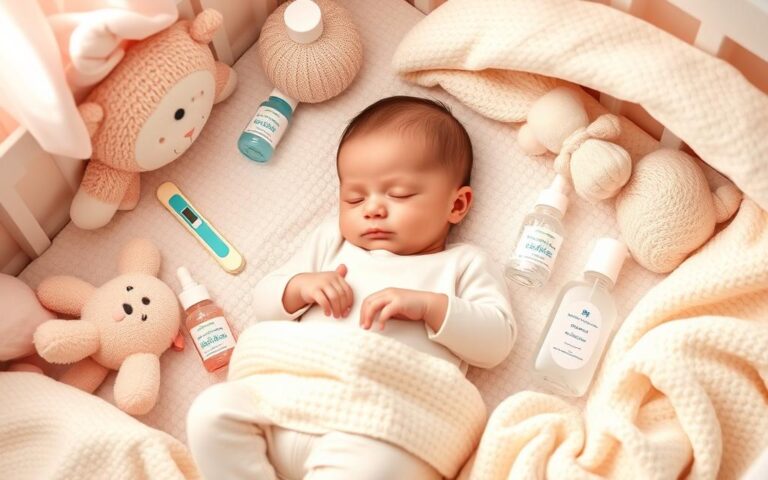Smooth Transition: Tips for Moving Your Child to a Toddler Bed

Switching to a toddler bed is a big step for kids and parents. It’s a move towards independence and can shape a child’s sleep habits for life. Making this change can be tough, but with the right steps, it can be a good experience for everyone. It takes patience, consistency, and a good plan to make the transition smooth.
Starting the journey to a toddler bed can feel scary. But remember, every child is different, and what works for one might not work for another. The goal is to find a balance between letting your child make choices and keeping a steady sleep routine. By making the switch to a toddler bed a positive one, you help your child develop good sleep habits that will last forever.
Key Takeaways
- A smooth transition to a toddler bed is essential for a child’s sleep habits and independence.
- Consistency and patience are key during the toddler bed transition.
- A good plan can make the switch to a toddler bed a positive experience.
- Every child is unique, and what works for one may not work for another.
- Finding a balance between freedom and consistency is vital for a successful toddler bed transition.
- Healthy sleep habits formed during the toddler bed transition can last a lifetime.
Signs Your Child is Ready for a Toddler Bed
As a parent, knowing when your child is ready for a toddler bed is key. This change is a big step in their growth. Spotting the signs of toddler bed readiness helps make the transition easier for everyone.
Look for physical signs like your child climbing out of the crib. This shows they have the skills to safely use a toddler bed.
Physical Signs of Readiness
- Ability to climb out of the crib
- Showing interest in a big kid bed
- Ability to follow simple instructions
Behavioral Indicators
Behavioral signs, like wanting a big kid bed, also show readiness. If your child can talk about their needs and is interested in using the bathroom, it’s time to think about toddler bed readiness.
Age-Related Milestones
Children usually get ready for a toddler bed between 2 and 3 years old. But, every child grows at their own pace. It’s important to watch your child’s development to see if they’re ready for moving to a big kid bed.
| Age | Signs of Readiness |
|---|---|
| 2 years | Ability to climb out of the crib, showing interest in a big kid bed |
| 2.5 years | Ability to follow simple instructions, communicating needs effectively |
| 3 years | Consistently demonstrating physical and behavioral signs of readiness |
Choosing the Perfect Toddler Bed
Switching from a crib to a toddler bed is a big step. It’s important to pick a bed that is safe, comfy, and looks good. Here are some toddler bed tips to help you choose the right one:
When picking a toddler bed, think about the type, material, and size. You might choose a convertible crib or a standalone bed. Here are some things to keep in mind:
- Space: Make sure the bed fits in your child’s room.
- Material: Pick a bed made from safe, durable materials.
- Style: Choose a bed that fits your child’s style and room.
Also, think about the bed’s safety features, like guardrails and a strong frame. A comfy mattress is key for a good night’s sleep. By thinking about these things and following these toddler bed tips, you can find the perfect bed for your child. This will make switching from crib to toddler bed easy.
Remember, the most important thing is your child’s comfort and safety. With the right bed and a bit of patience, your child will sleep well in their new bed soon.
| Bed Type | Material | Size |
|---|---|---|
| Convertible Crib | Wood | Standard |
| Standalone Toddler Bed | Plastic | Compact |
Essential Safety Features for Your Child’s New Bed
Setting up a toddler bed means safety first. At the right age, kids are curious and explore a lot. Making sure their bed is safe is key to avoid accidents.
Parents need to think about the bed, mattress, and room. Bed rails are a must to keep kids from falling. The room should also be free from dangers like sharp objects or outlets.
Bed Rail Requirements
Bed rails are vital for toddler beds. They must be strong and attached well. There are different types, like fixed and adjustable rails.
Room Safety Measures
A safe room is also important. It should be well-ventilated, at a good temperature, and free from hazards. Here are some ways to make a room safe:
- Installing window guards to prevent falls
- Securing any heavy furniture or objects to the wall
- Keeping the room tidy and clutter-free
Mattress Considerations
A good mattress is key for sleep. Choose one made for toddler beds and meets safety standards. A firm, snug mattress is best to prevent accidents.
How to Make the Transition to a Toddler Bed Easier
Getting ready for a toddler bed can be tough for parents. But, with a good plan, it can go smoothly for everyone. A key step is to set up a toddler bed sleep routine. This routine makes the child feel safe and helps them sleep well.
Creating a bedtime routine is important. It tells the child it’s time to sleep. This can be reading a book, singing a lullaby, or a relaxing bath. A steady bedtime routine helps the child relax and sleep better.
- Stick to a consistent sleep schedule
- Create a bedtime routine that works for your child
- Make the toddler bed a welcoming and comfortable space
By following these tips, parents can ease the transition to a toddler bed. Remember, every child is unique. Be patient and flexible when getting ready for a toddler bed. With a steady toddler bed sleep routine and a good plan, parents can help their child adjust smoothly.
Creating a Comfortable Sleep Environment
A good sleep environment is key for a smooth transition to a toddler bed. A cozy space can greatly help your child get used to their new bed. Think about how lighting and temperature affect your child’s sleep during this time.
A dark, quiet room with a steady temperature is best for sleep. Soft lighting and a comfortable temperature make a great sleep space. This helps your child sleep better and stay asleep as they get used to their new bed.
Lighting and Temperature
Use blackout curtains or shades to block out harsh light. A white noise machine can also make the room feel calm. Keep the room at 68-72 degrees Fahrenheit for the best sleep environment.
Comfort Items and Decorations
Favorite stuffed animals or blankets can offer comfort during the transition. Decorations like a mobile or nightlight can make the room feel more welcoming and cozy.
Room Layout Tips
A well-thought-out room layout can also help with sleep. Here are some tips:
- Place the bed away from the door and any windows
- Use a bed rail to prevent your child from falling out of bed
- Keep the room clutter-free and organized
By making the sleep environment comfortable, you can help your child adjust to their new bed. This makes the transition to a toddler bed a positive experience.
| Tip | Description |
|---|---|
| Consistent Sleep Schedule | Establish a consistent sleep schedule to help regulate your child’s sleep patterns |
| Bedtime Routine | Develop a calming bedtime routine to signal to your child that it’s time for sleep |
| Comforting Environment | Create a comforting environment by using soft lighting, comfortable temperatures, and cozy decorations |
Establishing a Consistent Bedtime Routine
When moving to a big kid bed, a consistent bedtime routine is key. It improves sleep quality and reduces bedtime struggles. As your child shows signs of toddler bed readiness, it’s important to create a routine that suits everyone.
A bedtime routine can include reading a book, singing a lullaby, or a relaxing bath. The goal is to make it predictable and calming. This helps your child relax and get ready for sleep. A consistent bedtime routine helps your child develop good sleep habits and makes the transition smoother.
Here are some tips for creating a bedtime routine:
- Set a regular bedtime and stick to it
- Create a calming pre-sleep environment, like dimming lights or playing soothing music
- Avoid screens and electronic devices before bedtime
By following these tips and setting a consistent bedtime routine, your child can adjust to their new toddler bed. They will develop healthy sleep habits that last a lifetime. Be patient and flexible, as every child is unique. It may take time to find the best routine for your child.
Managing Common Challenges During the Switch
Switching from a crib to a toddler bed can be tough for parents. One big problem is when kids keep getting out of bed. To solve this, having a set bedtime routine and a cozy sleep area is key. Toddler bed tips like using bed rails and placing the bed in a quiet spot can also help.
Another challenge is dealing with nighttime fears. This can be hard for both kids and parents. Being patient and reassuring is very important.
As Dr. Harvey Karp, a renowned pediatrician, suggests, “The key is to create a sense of safety and security for your child.”
By being there for your child and using calming methods, you can help them feel safe. This can lessen their nighttime fears.
Also, sleep regression can happen when kids start using a toddler bed. To fight this, keep a regular sleep schedule and have a calming bedtime routine. Here are some tips for dealing with sleep regression:
| Tips for Managing Sleep Regression | Description |
|---|---|
| Stick to a routine | Maintain a consistent sleep schedule and bedtime routine |
| Create a sleep-friendly environment | Ensure the room is dark, quiet, and at a comfortable temperature |
| Avoid screens before bedtime | Limit screen time at least an hour before bedtime to promote better sleep |
By using these toddler bed tips and being patient, parents can help their child adjust to the new bed. Remember, moving from a crib to a toddler bed is a big step. With the right approach, it can be a good experience for everyone.
Tips for Maintaining Sleep Schedule Success
After moving your child to a toddler bed, keeping a regular sleep schedule is key. At the right age, kids can start good sleep habits that last a lifetime. Create a bedtime routine with activities like reading or singing to show it’s time for sleep.
Keeping the bedroom safe is also important for a good sleep schedule. Make sure it’s dark, quiet, and comfy. Use blackout curtains, a white noise machine, or a fan to help. A steady sleep schedule and a safe room help your child sleep well and adjust to the new bed.
Here are more tips for keeping a good sleep schedule:
- Stick to a consistent bedtime and wake-up time, even on weekends
- Avoid screens and electronic devices before bedtime
- Encourage physical activity during the day to promote better sleep at night
- Make sure the toddler bed is comfortable and safe, with a firm mattress and tight-fitting sheets
By following these tips and keeping a regular sleep schedule, you can help your child sleep well. Always remember to keep the sleep environment safe for your child.
What to Do When Your Child Resists the Change
When you’re getting your child ready for a toddler bed, it’s key to have a steady sleep routine. But, some kids might not want to switch, making it tough for parents.
To help your child get used to the new bed, be patient and use good strategies. Try using positive rewards like stickers or small treats for sleeping in their new bed.
Strategies for a Successful Transition
- Communicate with your child: Explain why they need a new bed and let them help get ready.
- Make the new bed inviting: Add their favorite toys, blankets, or comfort items to make it cozy.
- Establish a bedtime routine: Create a calming, predictable bedtime signal to help them sleep.
By using these strategies and keeping a steady sleep routine, you can help your child get over their resistance. They’ll learn healthy sleep habits.
Every child is unique, so what works for one might not work for another. Be patient. With time, your child will get used to their new bed and sleep well.
| Strategy | Benefits |
|---|---|
| Positive Reinforcement | Encourages good behavior and motivates your child to sleep in their new bed |
| Communication | Helps your child understand the reasons for the change and feel more in control |
| Bedtime Routine | Signals to your child that it’s time for sleep and helps them wind down |
Celebrating Your Child’s Big Kid Milestone
The transition to a toddler bed is a big step for a child. It shows they are growing up. It’s important to celebrate this to make it a happy memory for everyone.
Here are some ways to celebrate:
- Throw a “big kid” party with friends and family
- Decorate their bedroom with new things
- Plan a special outing or activity
A smooth toddler bed transition needs patience and positive words. Celebrating this moment boosts your child’s pride and sense of achievement. It makes the change to a toddler bed a good experience for all.

By making this milestone fun, parents help their child feel good about their new bed. This sets a good start for their sleep habits in the future.
Celebrating your child’s big kid milestone shows you’re proud of their growth. It shows you’re excited to see them do well in their new bed.
Conclusion: Making the Toddler Bed Transition a Positive Experience
As your little one grows up, moving to a toddler bed is a big step. It’s key to be patient, understanding, and positive during this time. This milestone is important, and with the right steps, it can be smooth and rewarding for everyone.
Look for signs that your child is ready for a toddler bed. Choose a safe and comfy bed. Start a calming bedtime routine. This will help make the transition successful.
If problems come up, try positive reinforcement and talking openly. This can help your child feel better about their new bed.
This change is a chance to celebrate your child’s growth and independence. Be excited about this big step. Your child will feel more confident and secure in their new bed. With your support, this move to a toddler bed will be a special memory for them.





